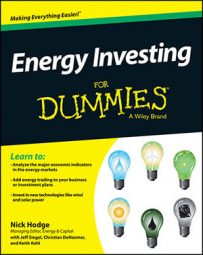Like all the energy fuels you can invest in — oil, gas, and coal — uranium can be traded as a commodity. Uranium, though, is primarily used for one thing, as opposed to the many end uses for other energy commodities. As such, its price is determined by the balance of supply and demand in the nuclear fuel market.
Uranium is a metal whose price is determined by its primary use as fuel for nuclear power plants. When investing in uranium as a commodity, keep in mind that
The uranium price is dictated by long-term private contracts between suppliers and utilities.
Uranium is a commodity, and like all commodities, it has a history of volatility.
Longer-term uranium prices move with the slower-changing philosophy of green movements.
Spikes and busts are driven by geopolitical black swan events, such as the Cigar Lake mining flood and the Fukushima power plant meltdown in Japan.
Unlike other metals like copper or tin, uranium isn’t traded on an organized commodity exchange, such as the London Metal Exchange. Historically, uranium prices were set through contracts negotiated directly between a buyer and a seller.
But in 2007, at the height of the uranium bubble, the New York Mercantile Exchange teamed up with Ux Consulting to create a futures contract that trades under the symbol UX. You can trade it on or off exchange in contracts of 250 pounds apiece. This exchange was created to offer a transparent price mechanism to miners, utilities, governments, and banks.
Individual investors can trade uranium futures, but given the volatility of pricing and the 250 pound minimum, which would be more than $10,000 at the 2013 uranium prices of more than $48 per pound, the risks outweigh the benefits.
Due to the small number of global producers and buyers of uranium and the heavily regulated nature of the market, the form of uranium supply contracts vary a great deal when they’re negotiated without an exchange. A buyer can lock in a fixed price, have prices based on points in the mining and milling process, or add in insurance based on economic corrections.
A nuclear power plant incurs high upfront costs based on long-term financing coupled with a 30- to 40-year life expectancy. Nuclear power plants can’t be turned off and on based on the short-term fluctuations of uranium prices. Therefore, a utility seeks to ensure long-term supply at a fixed cost.
Contracts traditionally specify a base price, such as the uranium spot price, and rules for escalation. In base-escalated contracts, the buyer and seller agree on a price that increases over the contract’s life on the basis of an agreed-upon formula, which may take economic data points, such as gross domestic product (GDP) or inflation factors, into consideration.
Obviously, due to uranium’s uniqueness, it differs from other commodities like gold and silver. You can’t own physical uranium, for example, although a fund does exist that does the owning for you.
The uranium sector is different in other ways. Utilities want low prices for their fuel, but they also want stability and guaranteed supply. So the market has evolved such that the buyer makes a purchase at various points in the supply cycle. The buyer may purchase enriched uranium, which is the end product, or buy the product underground, in the milling process, or in core form.
In this way, the utilities gain greater control over supply and lower the price for uranium. They also spread the contract out over multiple producers in case one runs into a supply problem and can’t fulfill its contract. The suppliers also seek long-term commitments because mining is a cash-intensive business. As in any market, there are brokers and traders.

